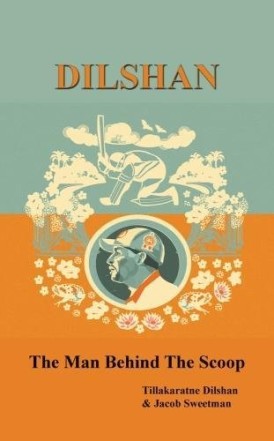Dilshan
Martin Chandler |Published: 2017
Pages: 144
Author: Dilshan, Tillakaratne and Sweetman, Jacob
Publisher: Wibble Books
Rating: 2.5 stars

There are several Sri Lankan cricketers regarding whom the cricket world is owed some sort of book. Top of the list are Muttiah Muralitharan, Mahela Jayawardene and Kumar Sangakkara, but I would also have put Marvan Atapattu, Chaminda Vaas and Duleep Mendis above Tillakaratne Dilshan. In any event, the third Sri Lankan, after Aravinda De Silva and Roshan Mahanama, whose story is told in book form is Dilshan, and an odd one it is too, published in Canada by a company previously unknown to me.
As the appearance of his name as co-author suggests, what is served up in Dilshan is not a biography. Neither is it a ‘ghosted autobiography’ in the traditional sense. The book consists of a good deal of Dilshan’s own thoughts, always italicised, woven together with a narrative from Sweetman. Such a template seems to me to be a very recent trend, inspired by two or three of our best current writers, but Dilshan demonstrates that approach doesn’t always work well, and the word ‘hagiography’ does spring to mind.
It probably doesn’t help this reviewer that Dilshan made his name in the shorter formats of the game, neither of which I am particularly keen on, although reading Dilshan reminded me of the excellent Test record he has, particularly after taking the relatively rare journey from the middle to the top order well into his career. In some quarters he will also be lauded for his inventiveness, and doubtless the ‘Dilscoop’ will guarantee his name remains known to future generations when those of other better players have been forgotten. That and his exploits in the IPL were never going to appeal greatly to me.
What about Dilshan the man? To be fair to Dilshan and Sweetman much of his personality does shine through, although not always in a positive light. His is something of a ‘rags to riches’ story, complete with the chip on the shoulder that not infrequently accompanies those who travel that road. There has also been some emotional debris left behind in Dilshan’s life. These are subjects on which his own views are never, for entirely understandable reasons, going to be of great assistance in assessing what really happened, but the reader is left suspecting a lack of candour at times. That said I suppose the mere fact that I was driven to the services of Mr Google to find out more suggests that the book does something right.
To the writers’ credit the book does set out to be concise, and there is nothing in the way of tedious match reporting. The voyage through Dilshan’s life is, nominally at least, a chronological one but in truth the narrative begins in 2007 and then jumps back regularly, and less often forwards, in order to tell the tale. There is no index nor, more irritatingly, any career statistics. That latter complaint made, it should be added that the book closes with a statistical chapter dealing with that concept called an ‘impact index’, a measure of little help to this reviewer, although that is perhaps by dint of lack of familiarity rather than because the idea is fundamentally flawed. The jury is still out on that one.
Dilshan is illustrated, but the photographs are a disappointing selection. In that respect, however, I am reminded of the old adage that one should be careful what one wishes for, and console myself with the thought that at least there is no appearance of the image from Dilshan’s Cricinfo page. In conclusion, therefore, this is a book that will certainly not appeal to everyone, but the story it tells is an illuminating one. Its subject does not come across as the most likeable of men, but in cricket as in all fields of human endeavour that tends to make the narrative more interesting rather than less.







Leave a comment